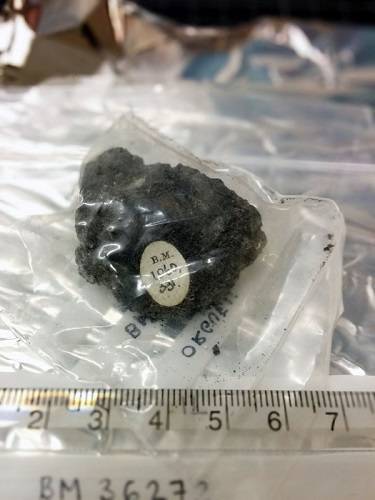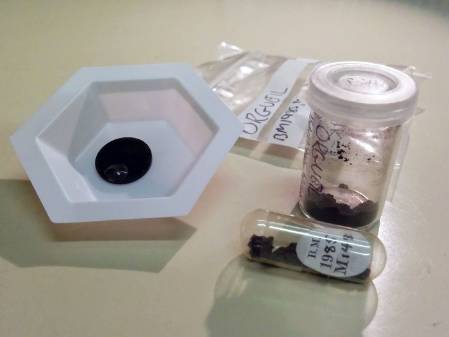As well as keeping you informed about our research we're going to use this blog to let you know more about our meteorite collection, especially the ones that aren't currently out on display.
All of us in the meteorite group are off to Casablanca, Morocco in September to present our research at the Annual Meeting of the Meteoritical Society (... more on that nearer the time). At the meeting there is going to be a special session about a very important meteorite called Orgueil.
It is 150 years since Orgueil was seen to fall in southern France (n.b. all meteorites are named after the place where they fell or were found so this one was seen to land near its namesake). We have several pieces of Orgueil, kept in the meteorite curation facility at the Museum.
Me in the meteorite curation area. Most of our meteorites are kept in drawers like this.
Orgueil is important because it is part of a rare group of meteorites called CI chondrites. There are only five known CI chondrite 'falls' and Orgueil is by far the biggest, weighing 14 kg. We only have a total of about 7 kg of the other four CI chondrites so they are all very precious.
[A quick diversion into terminology - when meteorites are seen to fall and land we call them 'falls'. If a meteorite is found but no one saw it fall then it is called a 'find'. Falls are more valuable to scientists because they can be recovered more quickly and so are less likely to experience contamination or chemical alteration during their time on Earth.]
A piece of Orgueil from our collection. All our meteorites have a unique number so that they can be identified.
When scientists analysed the chemistry of the CI chondrites they found that they are almost identical to the composition of the Sun. We think the chemistry of the Sun has stayed pretty much the same since it formed over 4.5 billion years ago and that the Sun contains over 99% of the mass in the Solar System.
This means that the Sun is very representative of the material that was present in the early Solar System; however it is very difficult to sample for what are probably obvious reasons. The compositions of other planets and many asteroids have been changed over time by chemical and physical processes so they are no longer representative of the early Solar System. As the CI chondrites are chemically very similar to the Sun we can study them to learn more about what the material in the Solar System was like when it formed 4.5 billion years ago.
Different analytical techniques require different sample preparation. Here we have Orgueil "three ways": a disk (left) for infra-red analyses, powder (back-right) for x-ray diffraction analyses and chips (front-right) that can be polished for scanning electron microscopy.
Another of the CI chondrites, Alais, also fell in France about 50 years before Orgueil. Alais was found in 1806, just three years after one of the first scientific reports of a meteorite fall.
The report was written by Biot, a member of the French Academy of Science, and convinced the scientific community that meteorites were extra-terrestrial (apparently it was a much more exciting read than an earlier report by the German physicist, Ernst Chladni). Before this time meteorites were thought to be terrestrial rocks that had been struck by lightning, or rocks ejected from volcanoes. If Biot's work had not been published it is likely Alais would have been thrown away because it was initially thought to be fossilised peat.
The other three CI chondrite falls fell in the 20th century and are called Tonk, Ivuna and Revelstoke. The biggest piece of Ivuna is kept in our collection. It has been stored in a nitrogen atmosphere for the past twenty to thirty years. This protects it from the Earth's environment.
We have the largest piece of Ivuna in a public collection anywhere. It is kept in a nitrogen environment to protect it from the Earth's atmosphere.
CI chondrites like Orgueil and Ivuna are also important as they contain organic material. This consists of molecules of carbon and hydrogen with some oxygen, nitrogen and sulphur. All this carbon makes the CI chondrites very black in colour - and perhaps easily mistaken for fossilised peat. They also contain a lot of water (up to 20%). One of our post-doctoral researchers, Ashley, is studying the mineralogy of Orgueil and other meteorites like it to find out more about water in the Solar System.
That the CI chondrites contain organic material and water is interesting because you need both these things in order for life to survive, and some people think that the building blocks for life on Earth could have been delivered by meteorites or comets. But - and it's a big but - you do not need life in order to have organic material and water, so they in themselves are not evidence of life coming from outer space.




